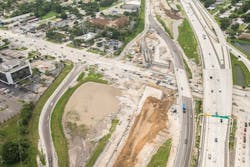NO. 3 ROAD: Coming out on top
How do you reconstruct an interstate on top of an old one while maintaining full traffic capacity and come in 140 days early, while saving $35 million against estimates? Answer: Take the 4.7-mile I-275 reconstruction in Tampa, Fla., as a model.
The limits of the project described a densely trafficked and populated urban area between S.R. 60 and Hillsborough River. The project area had been accomodating approximately 200,000 vehicles per day—and that level needed to be maintained with no compromise.
“Without a doubt the maintenance of traffic was our biggest challenge,” Conrad Campbell, FDOT interstate construction office resident engineer, told Roads & Bridges. “It’s an urban corridor that was being built on top of the old footprint (meaning no traffic diversion). We had to work right in it the whole time, and maintain three lanes of traffic in each direction.”
The project’s urban locale meant more than just dealing with a lot of cars. I-275 functions as a crucial—and in a specific case, lone—artery for commerce and extravehicular mobility.
“This particular corridor connects the airport and all the sports venues in Tampa,” Conrad said. “And if you want to get to the airport from St. Petersburg, you’ve got to use this corridor.”
In order to get the longest service life possible and the best bang for its buck, design firm WSP Parsons Brinkerhoff (WSP/PB) abandoned the flexible asphalt pavement that had been on the previous iteration, in deference to a rigid concrete pavement alternative.
“One of the factors is that rigid pavement gets lower maintenance and repair cycles,” John Dewey, project manager for WSP/PB, told Roads & Bridges. “For an urban interstate, reduced frequency of rehab and maintenance is key.”
Crews reconstructed the mainline interstate in-situ in three significant levels. After removing all previous material, a stabilized subgrade was placed at a thickness of 12 in., followed by 4 in. of asphalt structural course. Atop it all was a single, dense 14-in. lift of unreinforced concrete pavement. As a result of this process, the corridor now matches the pavement scheme of adjacent roadways, yielding FDOT a major win against future maintenance costs.
In order to lay such a massive volume of mix, joint venture partner Ajax Paving mobilized and set up an on-site batch plant. “They were laying it down so deep and so rapidly, the plant made all the difference,” Campbell said.
Now that the project is completed, the community benefit is clear.
“The neighborhood associations and the Tampa Sports Authority are quite pleased,” said FDOT consultant John McShaffery.
Project: I-275 from S.R. 60 to Hillsborough River
Location: Tampa, Fla.
Owner: Florida Department of Transportation
Designer: WSP Parsons Brinkerhoff
Contractor: Skanska-Ajax Paving J.V.
Cost: $224,900,000
Length: 4.7 miles
Completion Date: June 2016
